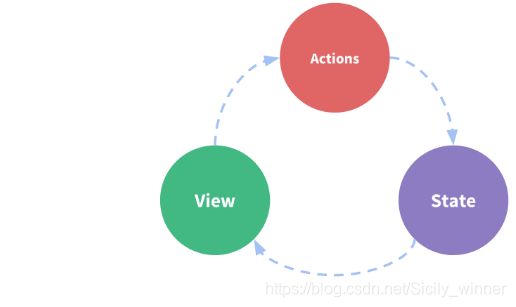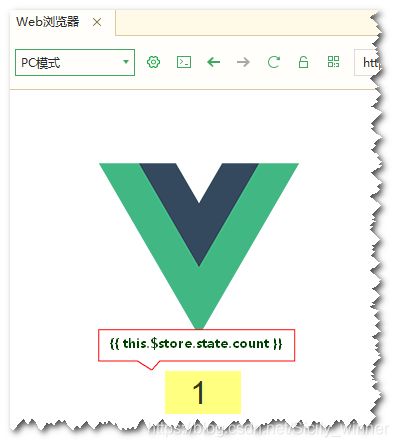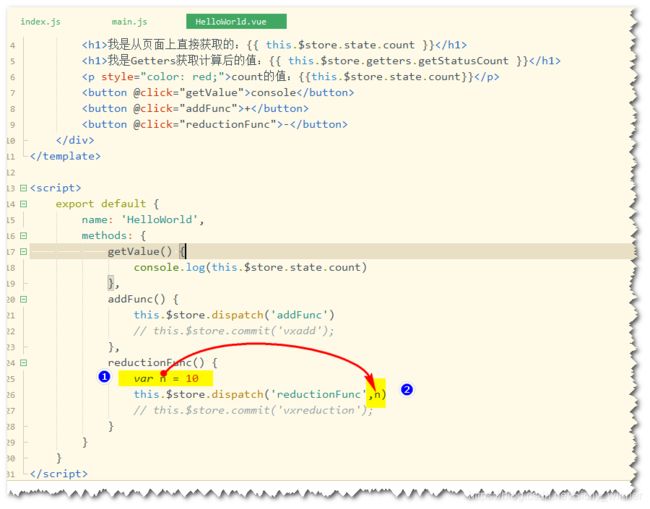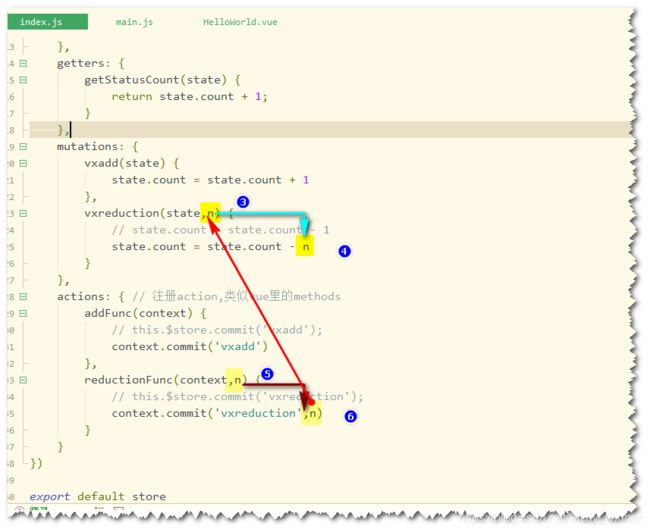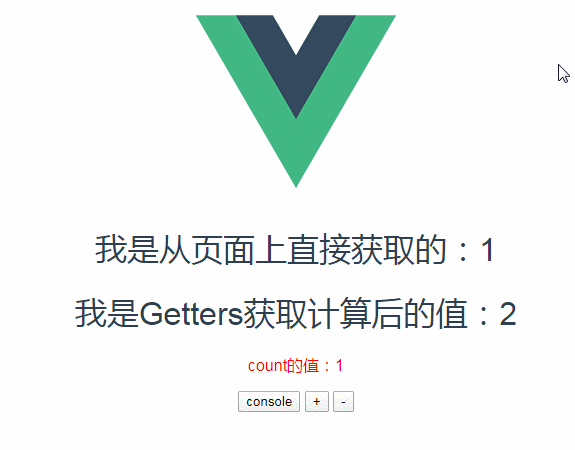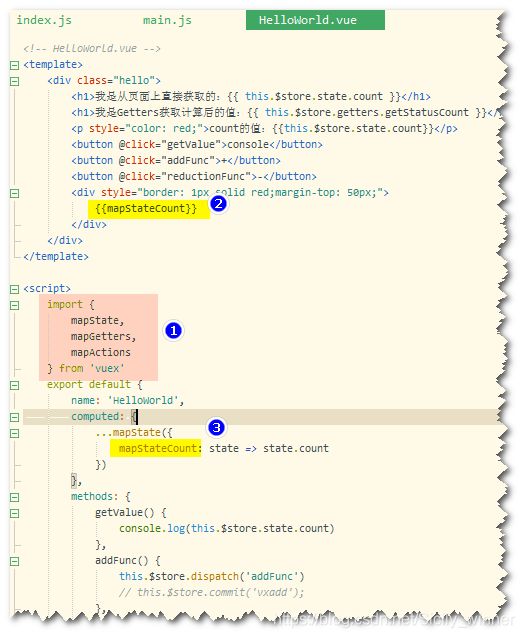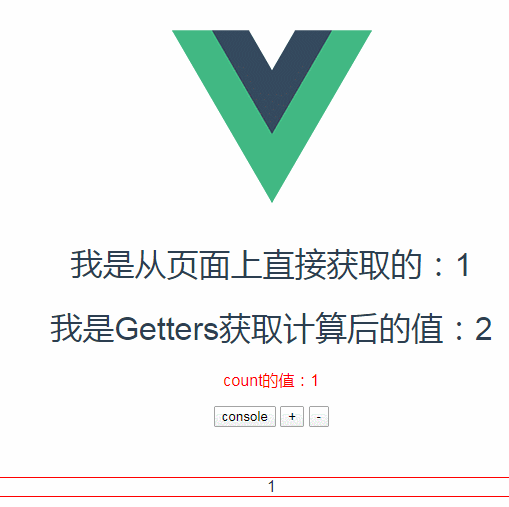vuex——状态管理插件(转)
我在网上看到一篇很好关于vuex使用的文章(转)所以本知识要点按照那篇文章操作。我们在使用vuex插件的时候,一定要使用npm install --save vuex,不然程序会报错,并且提示你请安装。
目录
☪ ?数组状态管理
► vuex状态管理〖实例〗
◆ ?如何安装vuex
◆ ?如何在项目中使用vuex
☪ Getters
◆ ㊫ Demo实战
⒈/src/store/index.js
⒉/src/componet/HelloWorld.vue
⒊效果
☪ Actions & Mutations
◆ ?数据我们在页面是获取到了,但是如果我们需要修改count值怎么办
◆ ㊫ Demo实战
先正常输出vuex中的count值
☪ 需要指定加减的数值
☪ mapState,mapGetters,mapActions
?数组状态管理
适合比较复杂的项目
- What is vuex?
- 为什么要使用状态管理?
如购物车信息,在淘宝的首页和个人中心等页面,同步显示和更新……vuex插件当数据发生变化,无论是计算还是watch都能够很好的实现;
统一的数据中心Store去维护各种状态数据,每一个组件在更新的时候,就通知数据中心Shared State,数据中心再去触发调用的对应组件。
► vuex状态管理〖实例〗
?如何安装vuex
npm install --save vuex(进入使用my-vuex执行语句)
?如何在项目中使用vuex
- 在src目录下创建store文件夹,在store文件夹下面创建index.js,实例化store数据中心(const store = new Vuex.Store({}))
/* index.js */ import Vue from 'vue' import Vuex from 'vuex' // 使用Vuex Vue.use(Vuex) // 创建Vuex实例 const store = new Vuex.Store({ state:{ count:1, }, }) export default store - 安装vuex插件(npm install --save vuex)
- mian.js入口处引入store,并且创建实例(import store from './store' & ,store)
// main.js import Vue from 'vue' import App from './App' import router from './router' import store from './store' Vue.config.productionTip = false /* eslint-disable no-new */ new Vue({ el: '#app', store, router, components: { App }, template: '' }) - 使用state属性在HelloWorld.vue中({{this.$store.state.count}})
{{ this.$store.state.count }}
- 如果在浏览器中出现下方结果,表示初步成功
 Getters
Getters
Vuex 的 store 中的状态的唯一方法是提交 mutation。Vuex 中的 mutation 非常类似于事件:每个 mutation 都有一个字符串的 事件类型 (type) 和 一个 回调函数(handler)。这个回调函数就是我们实际进行状态更改的地方,并且它会接受 state 作为第一个参数,payload作为第二个参数(额外的参数)
㊫ Demo实战
⒈/src/store/index.js
/* index.js */
import Vue from 'vue'
import Vuex from 'vuex'
// 使用Vuex
Vue.use(Vuex)
// 创建Vuex实例
const store = new Vuex.Store({
state:{
count:1,
},
getters:{
getStatusCount(state){
return state.count+1;
}
}
})
export default store⒉/src/componet/HelloWorld.vue
我是从页面上直接获取的:{{ this.$store.state.count }}
我是Getters获取计算后的值:{{ this.$store.getters.getStatusCount }}
⒊效果
 Actions & Mutations
Actions & Mutations
我们看到,当点击三次后值从2变成了-1;页面上的值是改变了;我们达到了修改store中状态值的目的;
但是,官方并不介意我们这样直接去修改store里面的值,而是让我们去提交一个actions,在actions中提交mutation再去修改状态值,接下来我们修改index.js文件,先定义actions提交mutation的函数:
?数据我们在页面是获取到了,但是如果我们需要修改count值怎么办
如果需要修改store中的值唯一的方法就是提交mutation来修改,我们现在Hello World.vue文件中添加两个按钮,一个加1,一个减1;
这里我们点击按钮调用addFunc(执行加的方法)和reductionFunc(执行减法的方法),然后在里面直接提交mutations中的方法修改值:
㊫ Demo实战
-
先正常输出vuex中的count值
-
/src/store/index.js
/* index.js */ import Vue from 'vue' import Vuex from 'vuex' // 使用Vuex Vue.use(Vuex) // 创建Vuex实例 const store = new Vuex.Store({ state: { count: 1, }, getters: { getStatusCount(state) { return state.count + 1; } }, mutations: { vxadd(state) { state.count = state.count + 1 }, vxreduction(state) { state.count = state.count + 1 } }, actions: { // 注册action,类似vue里的methods addFunc(context) { // this.$store.commit('vxadd'); context.commit('vxadd') }, reductionFunc(context) { // this.$store.commit('vxreduction'); context.commit('vxreduction') } } }) export default store -
发现getValue没有问题则复制this.$store提交到vuex.commit(方法)中,由原先的Mutations变成Action再提交到Mutations
我是从页面上直接获取的:{{ this.$store.state.count }}
我是Getters获取计算后的值:{{ this.$store.getters.getStatusCount }}
count的值:{{this.$store.state.count}}
-
终点两者效果是等同的
 需要指定加减的数值
需要指定加减的数值
那么我们直接传入dispatch中的第二个参数,然后在actions中的对应函数中接受参数在传递给mutations中的函数进行计算:
- 1 /src/componet/HelloWorld.vue
- 2 效果
- 3 效果
 mapState,mapGetters,mapActions
mapState,mapGetters,mapActions
如果我们不喜欢这种在页面上使用“this.$stroe.state.count”和“this.$store.dispatch('funName')”这种很长的写法,那么我们可以使用mapState、mapGetters、mapActions就不会这么麻烦了;
我们修改Hello World.vue文件如下:
- 1 HelloWorld.vue (...mapState-》mapStateCount: state => state.count)
我是从页面上直接获取的:{{ this.$store.state.count }}
我是Getters获取计算后的值:{{ this.$store.getters.getStatusCount }}
count的值:{{this.$store.state.count}}
{{mapStateCount}}
- 2 pic
- 3 效果图
